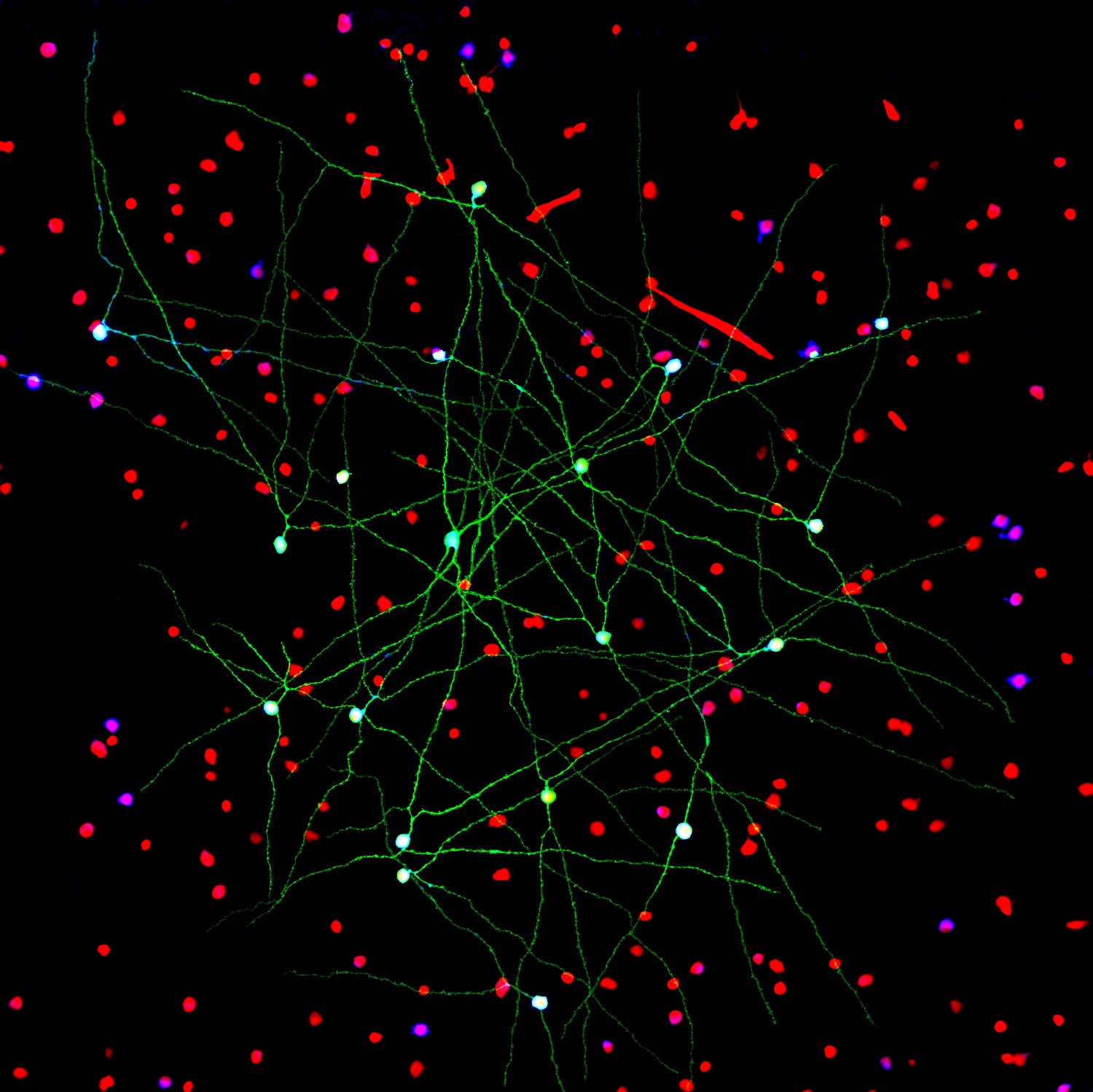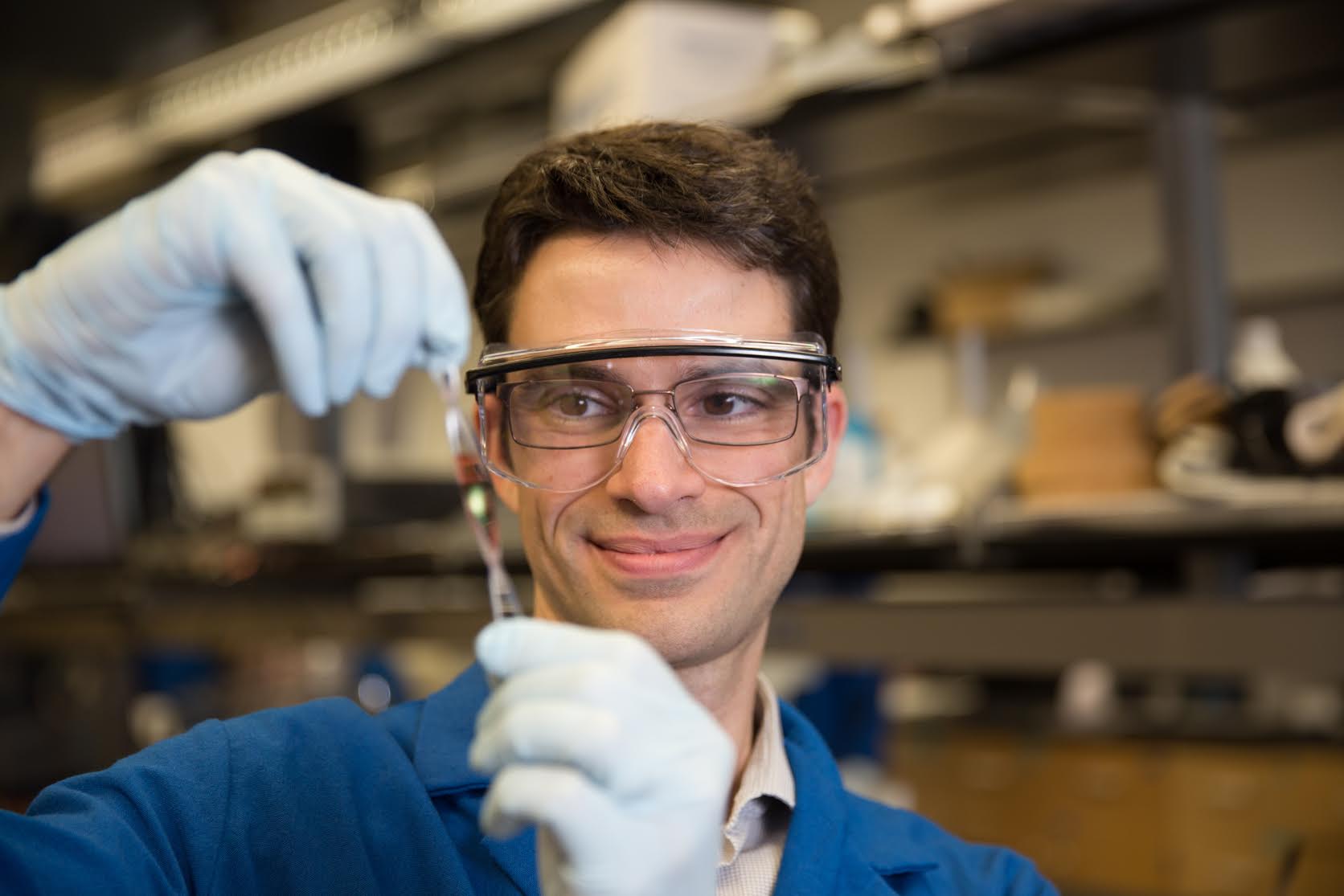2015 NIH Director’s New Innovator Award – NIH Director's Blog (original) (raw)
Creative Minds: Reverse Engineering Vision
Posted on July 28th, 2016 by Dr. Francis Collins

Caption: Networks of neurons in the mouse retina. Green cells form a special electrically coupled network; red cells express a distinctive fluorescent marker to distinguish them from other cells; blue cells are tagged with an antibody against an enzyme that makes nitric oxide, important in retinal signaling. Such images help to identify retinal cell types, their signaling molecules, and their patterns of connectivity.
Credit: Jason Jacoby and Gregory Schwartz, Northwestern University
For Gregory Schwartz, working in total darkness has its benefits. Only in the pitch black can Schwartz isolate resting neurons from the eye’s retina and stimulate them with their natural input—light—to get them to fire electrical signals. Such signals not only provide a readout of the intrinsic properties of each neuron, but information that enables the vision researcher to deduce how it functions and forges connections with other neurons.
The retina is the light-sensitive neural tissue that lines the back of the eye. Although only about the size of a postage stamp, each of our retinas contains an estimated 130 million cells and more than 100 distinct cell types. These cells are organized into multiple information-processing layers that work together to absorb light and translate it into electrical signals that stream via the optic nerve to the appropriate visual center in the brain. Like other parts of the eye, the retina can break down, and retinal diseases, including age-related macular degeneration, retinitis pigmentosa, and diabetic retinopathy, continue to be leading causes of vision loss and blindness worldwide.
In his lab at Northwestern University’s Feinberg School of Medicine, Chicago, Schwartz performs basic research that is part of a much larger effort among vision researchers to assemble a parts list that accounts for all of the cell types needed to make a retina. Once Schwartz and others get closer to wrapping up this list, the next step will be to work out the details of the internal wiring of the retina to understand better how it generates visual signals. It’s the kind of information that holds the key for detecting retinal diseases earlier and more precisely, fixing miswired circuits that affect vision, and perhaps even one day creating an improved prosthetic retina.
Tags: 2015 NIH Director’s New Innovator Award, age-related macular degeneration, brain, BRAIN Initiative, cerebral cortex, computational biology, computational neuroscience, connectivity matrix, diabetic retinopathy, eye, ganglion cells, macula, neurons, neuroscience, retina, retinal diseases, retinitis pigmentosa, reverse engineering, vision, vision loss, visual orientation
Creative Minds: Can Salamanders Show Us How to Regrow Limbs?
Posted on April 21st, 2016 by Dr. Francis Collins

Jessica Whited /Credit: LightChaser Photography
Jessica Whited enjoys spending time with her 6-year-old twin boys, reading them stories, and letting their imaginations roam. One thing Whited doesn’t need to feed their curiosity about, however, is salamanders—they hear about those from Mom almost every day. Whited already has about 1,000 rare axolotl salamanders in her lab at Harvard University and Brigham and Women’s Hospital, Cambridge, MA. But caring for the 9-inch amphibians, which originate from the lakes and canals underlying Mexico City, certainly isn’t child’s play. Axolotls are entirely aquatic–their name translates to “water monster”; they like to bite each other; and they take 9 months to reach adulthood.
Like many other species of salamander, the axolotl (Ambystoma mexicanum) possesses a remarkable, almost magical, ability to grow back lost or damaged limbs. Whited’s interest in this power of limb regeneration earned her a 2015 NIH Director’s New Innovator Award. Her goal is to discover how the limbs of these salamanders know exactly where they’ve been injured and start regrowing from precisely that point, while at the same time forging vital new nerve connections to the brain. Ultimately, she hopes her work will help develop strategies to explore the possibility of “awakening” this regenerative ability in humans with injured or severed limbs.
Tags: 2015 NIH Director’s New Innovator Award, Ambystoma mexicanum, amphibian, axolotl, axolotl salamander, blastema, CRISPR-Cas, limb regeneration, regenerative medicine, salamander, single cell analysis, single cell sequencing, tissue regeneration, transcriptome, vertebrate, wound epidermis, wound healing
Creative Minds: Stretching the Limits of Wearable Devices
Posted on April 7th, 2016 by Dr. Francis Collins

Darren Lipomi/ Credit: UC, San Diego
Whether it’s a pedometer dangling from a belt loop or a skin patch to monitor heart rate and hydration levels, wearable and mobile devices have become essential gear for many of today’s fitness minded. But Darren Lipomi, a nanoengineer at the University of California, San Diego, envisions even more impressive things to come for optimizing workouts and bringing greater precision to health care. Lipomi is helping to build a future of “stretchable electronics,” semiconducting devices that will more seamlessly integrate with the contours of our bodies, outside and even inside, to monitor vital signs, muscle activity, metabolic changes, and organ function—to name just a few possibilities.
Lipomi and his colleagues specifically want to create a new class of semiconducting polymer that has the mechanical properties of human skin. This transparent “electronic skin” will have a soft elasticity to conform to shape, sense contact, absorb blunt force, and even self heal when dinged. It will do all of this—and possibly more—while continuously and wirelessly performing its programmed health-monitoring function. To help Lipomi build this future of real-time health monitoring, he has been awarded a 2015 NIH Director’s New Innovator Award. This NIH award supports exceptionally creative new investigators who propose highly innovative projects with the potential for unusually high impact.
Tags: 2015 NIH Director’s New Innovator Award, bioelectronics, bioengineering, electronic skin, furan, materials science, mHealth, mobile health, mobile technology, nanoengineering, precision medicine, Precision Medicine Initiative Cohort Program, semiconducting polymers, skin, Star Trek, stretchable electronics, wearable sensors